This zesty taboule salad (also spelled tabouli salad or tabbouleh salad) is a bright and nutritious salad that you can make in a large batch and enjoy for several days to come.
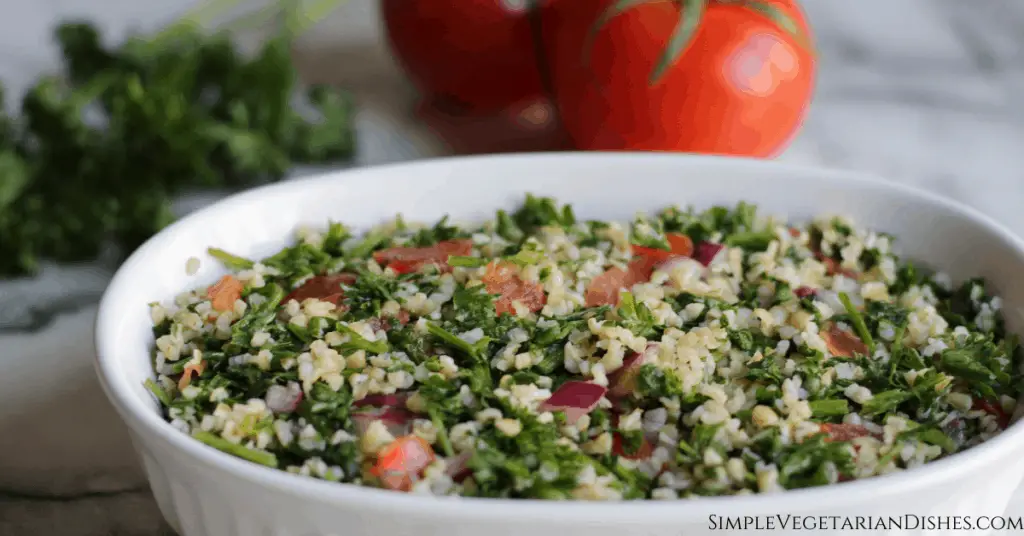
This parsley salad (or bulgur salad, depending on how you think of it) becomes more fragrant and delicious as it marinates and the flavors meld together, while never losing its fresh flavor.
Following my last post on Arabic salad where I extolled the virtues of parsley and why it is a powerhouse of good health, I wanted to make another dish where parsley was the star of the show.
When it comes to a parsley-heavy dish, there’s nothing better than taboule to feature this main ingredient. It’s a very popular recipe in my house. Conveniently, it is also a great way to use up a ton of parsley if your herb garden starts overflowing.
What is Taboule?
Taboule is a vegetarian salad traditionally served in the Eastern Mediterranean, also called the Levant, as part of a mezze. The mezze course contains small appetizers as part of a many course meal. In some regions, the mezze can be served alone, like tapas, while people sit, laugh, and converse.
You can serve taboule along with pita bread, baba ghanoush (or baba ganoush), hommus, tzatziki or haydari, dolmas or dawali, marinated Arabic salad, and other dishes less familiar in the West.
The principal ingredient in taboule is finely chopped parsley, with fresh tomatoes, onion, and bulgur wheat. It is dressed with lemon juice and olive oil to let the main ingredients shine. Taboule is thought to originate in Lebanon or Syria.
Traditional tabbouleh/taboule and similar mezze recipes are a fun way to add new healthy salads to your diet!
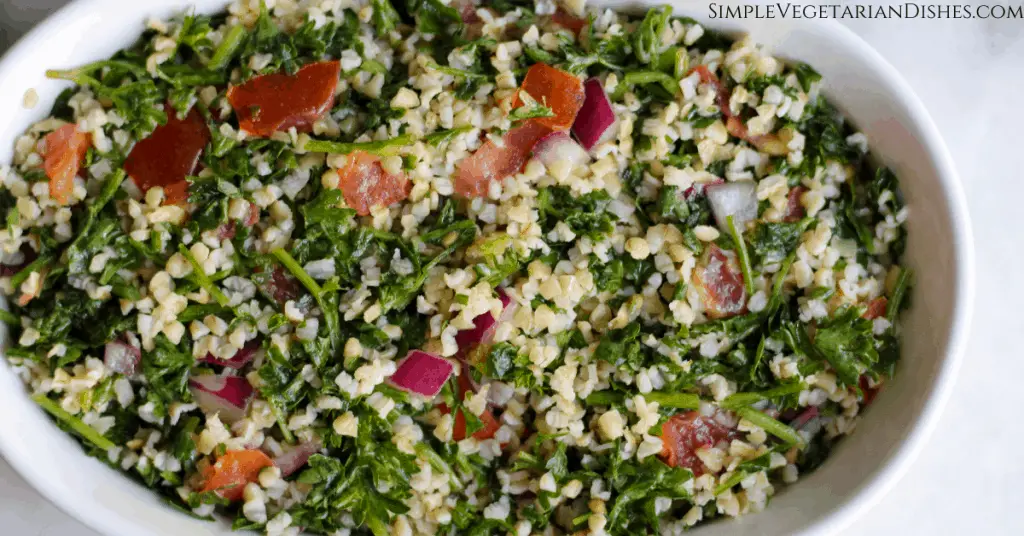
Related Mezze Posts
- Arabic Salad with a digression on how parsley supports good health.
- Dawali, aka stuffed grape leaves. A bit of a time-consuming labor of love, but absolutely worth it!
- Haydari, or Turkish yogurt dip (similar to tzatziki).
- Hommus (or hummus, if you prefer – chickpea and tahini dip).
Why is this recipe different?
Traditional Lebanese taboule has much less bulgur in proportion to parsley – more along the lines of 1/4 cup or 1/3 cup bulgur with 3 to 4 bunches of parsley. It also uses green spring onions rather than red onion. It is visually a much greener salad that is very nutritious.
I changed my version for two reasons. First, adding more bulgur makes it more of a meal and less of a side, although this traditional Lebanese salad does make a perfect side dish. This is often an important consideration for vegetarians. Second, I was trying to make a homemade version of a rather expensive pre-packaged (in small packaging, no less) taboule salad I have spent no small sum on over the years at my local grocery store. Theirs features a higher ratio of bulgur to parsley and uses red onion, like mine.
A fresh salad like this is very forgiving in terms of proportions. I tried this at several stages throughout the process and it was good each time. Feel free to adjust ingredients or proportions based on what you have at home and what you think your family will prefer.
If you are concerned about extra bulgur affecting your macros (such as total carbs and total fat), you can find the full nutritional information with the % daily values in the recipe card at the bottom of this post.
Pin it for later!
What kind of parsley should I use to make this taboule/tabbouleh recipe?
I personally prefer curly parsley, which is convenient as it is sometimes less expensive.
You can use Italian parsley, or flat-leaf parsley, if preferred, but the curly parsley holds the bulgur nicely. It looks like tiny green taco shells, which I find cute.
That being said, use whatever you like best. The most important thing with an herb salad like this is that you enjoy it so that you actually eat it and get the nutritional benefits.
Important tip
After washing your parsley, you may wish to use a salad spinner to get some of the excess water off. That way, less bits will stick to your hands and knife once you start chopping or using the food processor.
What kind of fresh tomatoes should I use?
I usually just buy tomatoes on the vine for this recipe. A few times I used Roma tomatoes, and they were also very good.
Some people like cherry tomatoes in this recipe too. Feel free to experiment.
Make sure to avoid tomatoes that have become mealy or mushy. For the most appetizing texture, you really want firm chopped tomatoes. You can drain off excess juice if desired, but I usually leave it in to add to the dressing.
What is Bulgur and How Do I Cook it?
Bulgur is a whole grain cereal made from parboiled cracked wheat. That means that when you buy bulgur it is already partially cooked. Traditionally, taboule uses very fine grain bulgur (look for extra fine bulgur when shopping), and you just put it in with the salad dressing or in a small bowl and let it absorb the moisture, without having to cook it first.
In my grocery store, I could only find one type of bulgur and it was in larger grains, which is why I soak mine with an equal part of boiling water for 20 minutes. I found the texture pleasantly chewy with no hard pieces, but if you wanted to be sure it was soft you can also boil bulgur in a medium pot for 12 minutes or so. This is helpful for coarse bulgur, or even for medium bulgur.
As bulgur is a wheat product it contains gluten, so if you are sensitive to that you can use quinoa instead to make a gluten-free taboule.
If you are curious about some of the health benefits of bulgur and why you might want to eat some, you can check out this article from healthline.
Is it bulgur or bulgar?
Technically both are correct, as far as I can tell, as is bulghur. However, bulgur wheat seems to be the most common spelling.
Make it Gluten-Free
Use quinoa in place of bulgur to make this a gluten-free recipe.
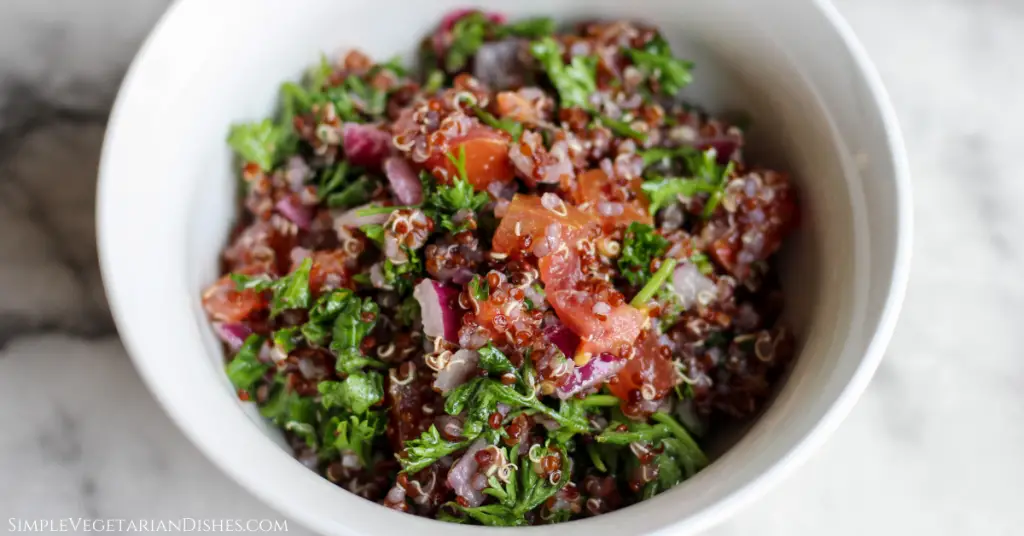
To make red quinoa in the Instant Pot, simply add 1:1.5 parts rinsed red quinoa (1 cup for this recipe) and water (1 1/2 cups) with a pinch of salt to the inner chamber. After that, pressure cook on manual mode for 14 minutes.
Make it a French taboulé with couscous
You can use couscous instead of bulgur if that’s what you already own to make this a couscous salad, otherwise known as French taboulé.
Variations on Taboule
With just a handful of ingredients, you can easily add your own stamp to a traditional Lebanese tabbouleh/taboule. Here are some top favorite things to get you inspired.
Add a cucumber (or English cucumber) for a more refreshing salad. This does change the flavor significantly, but it’s also quite tasty.
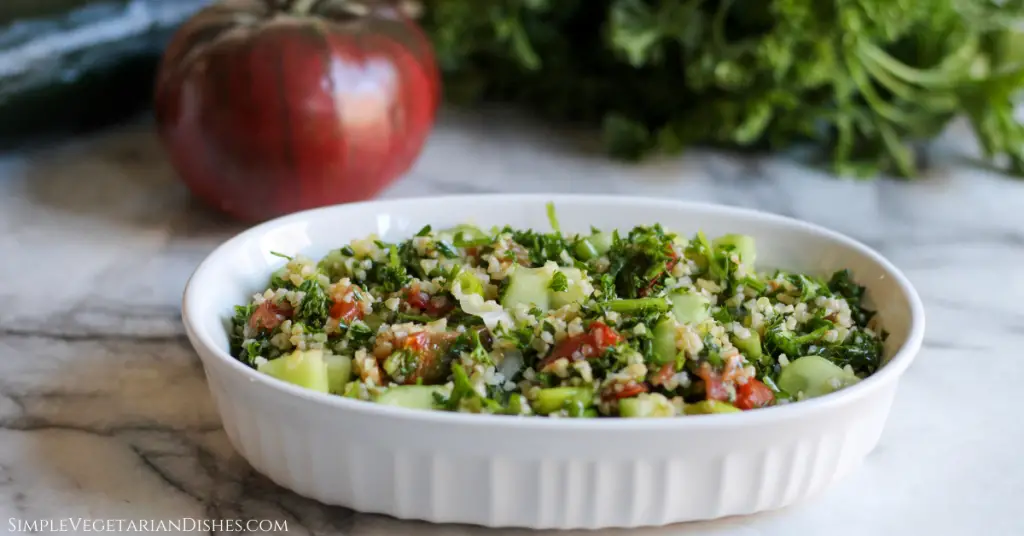
Add chopped fresh mint leaves as well – I plan on trying it this way soon!
Use lime juice instead of lemon (or both!) for a different flavor. Fresh lemon juice has wonderful flavor and avoids the manufactured citric acid and potassium sorbate used as preservatives, but bottled is fine too and absolutely better than nothing.
You could also try different flavored/infused olive oils if you think they will be compatible.
Some recipes call for pomegranate seeds (arils) instead of tomato.
You can also add in red bell peppers if desired, as red peppers are common in Lebanese cuisine. This is more common with French taboule.
As mentioned earlier, play with the types of onion used and the proportions to see how you like it best.
Feel free to add a dash of cayenne pepper or any additional fresh herbs you’d enjoy.
If you like a bit of parsley, but find lots of fresh parsley somewhat overpowering, you can substitute romaine lettuce for a portion of the parsley. This may not be considered authentic tabbouleh/taboule, but again, making something with healthy ingredients that you enjoy eating is pretty important in the big picture of cooking.
Alternatively, you can serve this taboule in romaine lettuce boats as fun party finger food!
Try sunflower oil instead of olive oil in this taboule/tabouli recipe.
If you found this article helpful, please consider joining my email newsletter community for new recipes delivered straight to your inbox!
Do I really need a food processor?
Not at all.
The first time I made this Middle Eastern salad, I used a food processor. However, every time since, I’ve just chopped the parsley with a chef’s knife.
So did it work?
As you may be wondering, yes, this version turned out remarkably similar to the version I was buying at the store.
Now that I know how to make it, I can make a much larger batch for around the same price. While it is possible I may buy it again when life gets busy, this recipe was done in the time it would have taken to drive to the store, wait in line, and come home.
Plus, I get leftovers!
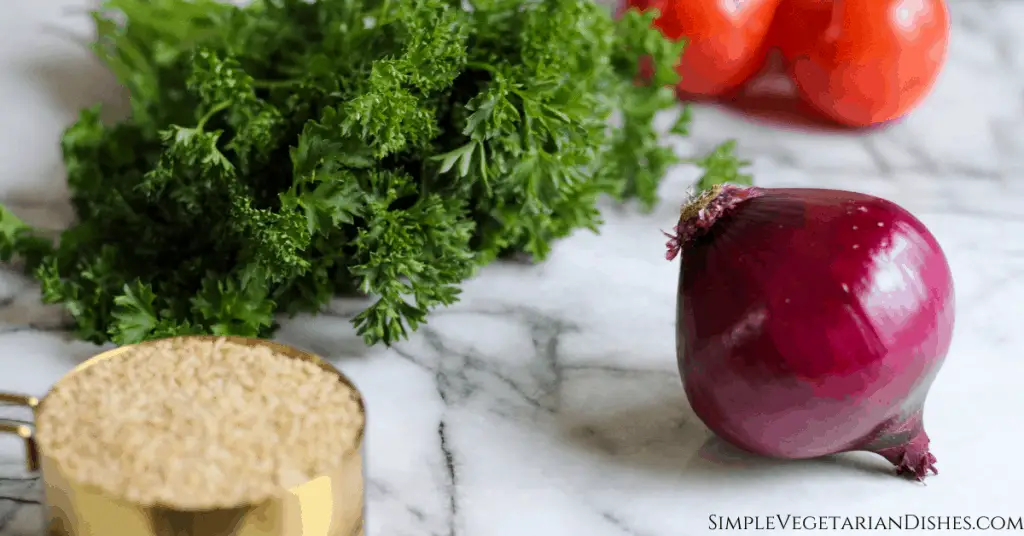
Taboule Ingredients
Before you begin, you will need:
- 1 cup bulgur
- 1 cup boiling water
- 2 bunches curly parsley (of flat leaf parsley if preferred)
- 2 medium tomatoes, washed
- 1/3 red onion
- 1 tsp salt
- 1/4 tsp allspice
- 1/2 cup lemon juice
- 1/4 cup extra virgin olive oil
- Optional: black pepper and sea salt to taste
- Two large bowls
- Kettle or saucepan to boil water (or microwave I suppose)
- Food processor or allow more time for chopping finely
- Sharp knife and cutting board
- Mixing spoon
Taboule Instructions
- First, pour the bulgur into a large bowl. Bring 1 cup of cold water to a boil, and then add the hot water to the bulgur. Stir and let it sit for about 20 minutes while you chop everything else.
- Next, roughly chop the parsley so it will fit into a food processor and use that to save some time chopping. I had to do several batches as I have a quite small food processor. Set aside in a different bowl.
- Then, dice the tomatoes as finely as you have patience for and add them to the parsley.
- Next, dice the onion and place it with the parsley and tomatoes.
- Once your bulgur has been soaking for about 20 minutes, it should be al dente. Pour the lemon juice, olive oil, salt, and allspice over the bulgur and stir it all together until everything is coated with the dressing.
- Finally, add all the chopped parsley, tomato, and onion and stir until well blended.
- Taste and see if you want any more of any of the seasoning while everything is still out.
Taboule is tasty right away, but let it sit longer for a more cohesive flavor (at least 30 minutes at room temperature or in the fridge, then fridge it in an airtight container). Leftover taboule the next day is delicious!
If you try this recipe at home, I’d love to hear how you like it in the comments. If you love it, please rate my recipe with five stars!
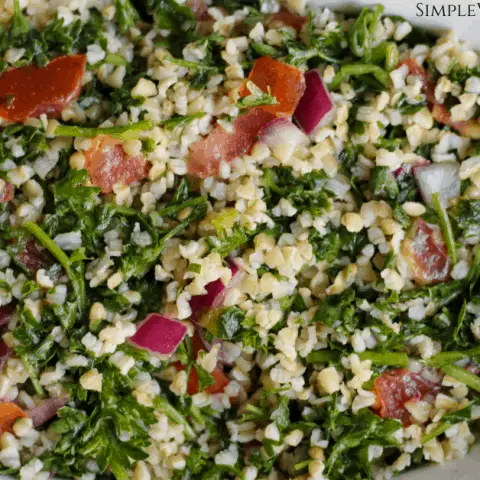
Taboule
This zesty taboule salad (also spelled tabouli or tabbouleh) is a bright and nutritious salad you can make in a large batch and enjoy for several days. It becomes more fragrant and delicious as it marinates and the flavors meld together.
Ingredients
- 1 cup bulgar
- 1 cup boiling water
- 2 bunches curly parsley, washed
- 2 medium tomatoes, washed
- 1/3 red onion
- 1/2 cup lemon juice
- 1/4 cup olive oil
- 1 tsp salt
- 1/4 tsp allspice
Instructions
- First, pour the bulgar into a large bowl and add the hot water. Stir and let sit about 20 minutes while you chop.
- Next, roughly chop the parsley so it will fit in a food processor and use that to save some time chopping. I had to do several batches as I have a quite small food processor. Set aside in a different bowl.
- Then, dice the tomatoes as finely as you have patience for and add them to the parsley.
- Dice the onion and place it with the parsley and tomatoes.
- Once your bulgar has been soaking for 20 minutes, it should be al dente. Pour the lemon juice, olive oil, salt, and allspice over the bulgar and stir it in.
- Add all the chopped parsley, tomato, and onion and stir until blended.
- Taste and see if you want any more of any seasoning.
Nutrition Information:
Yield: 8 Serving Size: 1Amount Per Serving: Calories: 149Total Fat: 14gSaturated Fat: 2gTrans Fat: 0gUnsaturated Fat: 11gCholesterol: 0mgSodium: 299mgCarbohydrates: 7gFiber: 2gSugar: 1gProtein: 1g

Lisa
I’ve never cooked with bulgar before and always love trying new recipes. This looks delicious!
TaraSVD0
Thank you! I hope you like it!